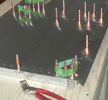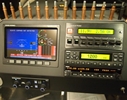


random user submitted photo
Dimple Hole Stretch Issue
10 posts
• Page 1 of 1
Dimple Hole Stretch Issue
I have a hole stretch issue.
I just drilled eight 1/8 holes in two .032 inch 6061T6 stabilator spar to rib attachment structure. The Sonex plans say to dimple and pull a CCC-42 countersunk pop rivet. However, if I dimple the 1/8 inch hole, it will open up too much and the rivet may not set. I failed to downsize the drill a few sizes to account for the hole stretch.
Should I either:
A) Machine the countersink instead of dimpling?
B) Combination of 50% machine countersink and 50% dimpling?
C) Upsize to CCC-52 rivet (or similar stainless / stainless rivet) and dimple?
D) Install a 1/8 inch stainless steel reinforcement washer behind the rivet? This would ensure the rivet sets properly. This is a common exterior aircraft grade washer used on countersunk fiberglass wing tips. This washer would have to be ground to fit properly, but would ensure structural integrity.
E) Install "backer" aluminum with downsized dimpled hole for the rivet to grab?
I just drilled eight 1/8 holes in two .032 inch 6061T6 stabilator spar to rib attachment structure. The Sonex plans say to dimple and pull a CCC-42 countersunk pop rivet. However, if I dimple the 1/8 inch hole, it will open up too much and the rivet may not set. I failed to downsize the drill a few sizes to account for the hole stretch.
Should I either:
A) Machine the countersink instead of dimpling?
B) Combination of 50% machine countersink and 50% dimpling?
C) Upsize to CCC-52 rivet (or similar stainless / stainless rivet) and dimple?
D) Install a 1/8 inch stainless steel reinforcement washer behind the rivet? This would ensure the rivet sets properly. This is a common exterior aircraft grade washer used on countersunk fiberglass wing tips. This washer would have to be ground to fit properly, but would ensure structural integrity.
E) Install "backer" aluminum with downsized dimpled hole for the rivet to grab?
Building electric Xenos
President, EAA Chapter 1250
President, EAA Chapter 1250
-

taildragger - Posts: 48
- Joined: Wed Aug 04, 2021 6:13 am
- Location: Pottstown, PA
Re: Dimple Hole Stretch Issue
Have you tried it on a piece of scrap? How much stretch do you really expect? Maybe it won't be so bad. I have inadvertently drilled some at 1/8 and it wasn't any problem. The rivets did just fine.
- Scott Todd
- Posts: 374
- Joined: Mon Jun 24, 2019 7:40 pm
- Location: Chandler, AZ
Re: Dimple Hole Stretch Issue
I built mine about 10 years ago and Sonex has (I hope) fixed the problem with their dimple dies by now, but the set they sent me had much too steep an angle which caused the holes to open excessively. Had die set for the smaller 3/32" rivets that purchased elsewhere and noted it had a much shallower angle that was a better match to the rivets so made my own die which is really easy if you have a even small bench top lathe. (The end of a standard 188 degree drill; bit was ideal to make the concave seat.) Take a look at side view of your rivets and the dimple die and see if the angles look similar. If the die is much steeper, purchase or make new die. Even with the new die, I found a #32 drill to be best.
David A.
David A.
- DCASonex
- Posts: 935
- Joined: Mon Sep 12, 2011 8:04 pm
- Location: Western NY USA
Re: Dimple Hole Stretch Issue
Building my Xenos, I used a #31 drill bit, 0.1200", for dimpled holes.
Bill Volcko XNS0068
Xenos A N68WV 99% flush rivets
Aerovee and Prince P-Tip
MGL Discovery Lite w/ Sandia STX 165R
V6
First hole 4/1/16
First flight 8/24/18
Phase I complete...finally!!!
Also flying a Challenger II since 1999
Xenos A N68WV 99% flush rivets
Aerovee and Prince P-Tip
MGL Discovery Lite w/ Sandia STX 165R
V6
First hole 4/1/16
First flight 8/24/18
Phase I complete...finally!!!
Also flying a Challenger II since 1999
-

bvolcko38 - Posts: 284
- Joined: Fri Feb 19, 2016 7:40 am
- Location: Finger Lakes
Re: Dimple Hole Stretch Issue
Another option is use AN426-4-xx rivets and squeeze or buck them. They swell to fill the larger hole. This can be done on the top skins and the bottom are installed with blind rivets. That is how my Xenos is built.
Rick Caldwell
Xenos 0057
Rick Caldwell
Xenos 0057
- racaldwell
- Posts: 400
- Joined: Thu May 22, 2014 4:52 pm
Re: Dimple Hole Stretch Issue
I experimented with some scrap .025 stock. I agree, if you drill a 1/8" hole and then dimple, the hole will be larger than it should be. I also experimented with the dimple dies. The Sonex dimple dies are slightly too large and the Aircraft Spruce dies are slightly too small. I went with the Sonex dies and turned them down slightly in the lathe to make a smaller dimple. I tried a #33 drill first, which was ok but ultimately ended up with using a #35 drill. After drilling and dimpling the 1/8 CCC rivets fit very snug.
To make sure that my rib/skin alignment stayed true, I clecoed every other hole with a 3/32" cleco and then drilled the remaining holes (everyother) with the #35 drill. After disassembling the skin from the ribs I drilled the remaining 3/32" holes with the #35 drill bit. After dimpling and reassembling the skin to the ribs, I first riveted the first holes that I had drilled to make sure that everything stayed true, then riveted the holes that I had drilled after the disassembly process. It worked well for me.
Hope that this helps.
Steve
To make sure that my rib/skin alignment stayed true, I clecoed every other hole with a 3/32" cleco and then drilled the remaining holes (everyother) with the #35 drill. After disassembling the skin from the ribs I drilled the remaining 3/32" holes with the #35 drill bit. After dimpling and reassembling the skin to the ribs, I first riveted the first holes that I had drilled to make sure that everything stayed true, then riveted the holes that I had drilled after the disassembly process. It worked well for me.
Hope that this helps.
Steve
- Stevetin
- Posts: 26
- Joined: Fri Jul 17, 2020 9:08 am
Re: Dimple Hole Stretch Issue
Thanks for your replies. I dimpled two scraps and the rivet pulled better than expected. See photos. The enlargement was minimal because I hypothesize that the 120 degree angle makes for minimal dimple depth.
Question:
Can a solid aluminum rivet like the AN426-4 replace a stainless blind rivet in terms of performance?
Question:
Can a solid aluminum rivet like the AN426-4 replace a stainless blind rivet in terms of performance?
- Attachments
-
- RIVET CLEARANCE NOT EXCESSIVE, PULLS FINE
- IMG_4640.jpg (120.67 KiB) Viewed 5422 times
-
- RIVET LIES FLAT
- IMG_4641.jpg (12.04 KiB) Viewed 5422 times
Building electric Xenos
President, EAA Chapter 1250
President, EAA Chapter 1250
-

taildragger - Posts: 48
- Joined: Wed Aug 04, 2021 6:13 am
- Location: Pottstown, PA
Re: Dimple Hole Stretch Issue
You're asking if aluminum can replace steel. Maybe...If it was designed that way...
- Scott Todd
- Posts: 374
- Joined: Mon Jun 24, 2019 7:40 pm
- Location: Chandler, AZ
Re: Dimple Hole Stretch Issue
Sonex says on the FAQ page that solid 2117 rivets (AN470 & 426) rivets can be used in place of the SS pulled rivets.
Sonex uses 1/8" rivets and my RV-6 sitting next to my Xenos uses 3/32" rivets. The rivet pitch is very similar in most places. P. Anson did some coupon testing and came to the conclusion the 1/8" pulled rivet matches the strength of the 3/32" driven rivet when both tension and shear are taken into account. The 1/8" driven rivet exceeded the 1/8" pulled rivet. The driven rivet swells in the hole and grips both sides of the sheets with more contact area than the rounded contact area of the pulled bulb end. Of course, both types of rivets exceed the design performance needed to keep our planes together.
But I must say, flying my Xenos and seeing the wing top skin oil canning all puckered up like it does makes me very glad I used solid rivets in that top skin. The skin is trying to pull up dramatically on those rivets. They are not in pure shear.
Rick Caldwell
Xenos 0057 26 hrs
Sonex uses 1/8" rivets and my RV-6 sitting next to my Xenos uses 3/32" rivets. The rivet pitch is very similar in most places. P. Anson did some coupon testing and came to the conclusion the 1/8" pulled rivet matches the strength of the 3/32" driven rivet when both tension and shear are taken into account. The 1/8" driven rivet exceeded the 1/8" pulled rivet. The driven rivet swells in the hole and grips both sides of the sheets with more contact area than the rounded contact area of the pulled bulb end. Of course, both types of rivets exceed the design performance needed to keep our planes together.
But I must say, flying my Xenos and seeing the wing top skin oil canning all puckered up like it does makes me very glad I used solid rivets in that top skin. The skin is trying to pull up dramatically on those rivets. They are not in pure shear.
Rick Caldwell
Xenos 0057 26 hrs
- racaldwell
- Posts: 400
- Joined: Thu May 22, 2014 4:52 pm
Re: Dimple Hole Stretch Issue
Thanks Rick. Would you call that the “Pucker Factor”? LOL To put your mind at ease, a fabric airplane has a Ballooing Factor, where the fabric pulls up in flight. I would think metal planes have a lot less puckering than fabric.
That said, my wings and fuselage are being built at the Sonex factory. It’ll be interesting to see if they have less oil-canning or puckering than home built. This would be the subject of another discussion.
I still wonder why the dimpled 1/8 inch hole did not spread out like I expected.
That said, my wings and fuselage are being built at the Sonex factory. It’ll be interesting to see if they have less oil-canning or puckering than home built. This would be the subject of another discussion.
I still wonder why the dimpled 1/8 inch hole did not spread out like I expected.
Building electric Xenos
President, EAA Chapter 1250
President, EAA Chapter 1250
-

taildragger - Posts: 48
- Joined: Wed Aug 04, 2021 6:13 am
- Location: Pottstown, PA
10 posts
• Page 1 of 1
Who is online
Users browsing this forum: No registered users and 7 guests







